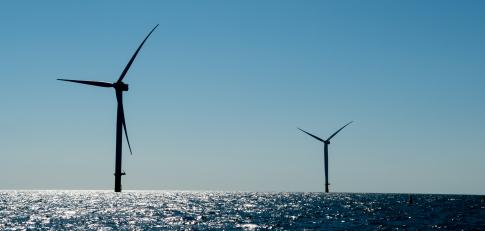By Philip Walzer
Virginia's offshore wind energy initiative, powered by Old Dominion University's research and coordination, came to life in August with the launch of operations of two turbines on the Atlantic Ocean.
ODU and Dominion Energy, the developer of the pilot project, organized a boat trip last week to provide an up-close look at the turbines at work 27 miles off the Virginia Beach coast. The trip was limited to 35 participants to observe distancing guidelines.
"I'm proud that Old Dominion is harnessing its talents to contribute to what promises to be a crucial milestone in energy innovation," ODU President John R. Broderick said, "and I'm excited we are now able to show off the first phase of what we hope will be the largest wind farm in the country."
It also is the first wind energy project in federal waters and the only one in the Southeast, said Paul Olsen, executive director of programs and partnerships for ODU's Office of Research, who is coordinating the University's involvement in the initiative.
Each of the two pilot, or research, turbines now in operation has three 235-foot-long blades and stands 614 feet tall - more than 100 feet higher than the state's tallest building, the Westin Virginia Beach Town Center. The turbines were made by Orsted Energy of Denmark, a leading company in wind. They will be used as "a test bed to demonstrate innovative technologies and design methods that will reduce the cost of offshore wind energy" on future projects, said George Hagerman, ODU's lead researcher.
The Coastal Virginia Offshore Wind project is scheduled to be finished in 2026, with at least 185 turbines at an estimated cost of $7.8 billion. The wind farm will be able to produce 2.6 gigawatts of power - enough to supply about 650,000 homes. Gov. Ralph Northam, who visited the pilot turbines over the summer, this year signed legislation setting a statewide target of installing 5.2 gigawatts of wind power by 2034.
The governor this week announced the creation of the Mid-Atlantic Wind Training Alliance, which will provide certifications for employees in the offshore and onshore wind industry.
"My dream has always been for the work I do to actually have a material benefit to my neighbors in the coastal community in which I live," Hagerman said. "These turbines do that."
Hagerman, senior project scientist at ODU's Center for Coastal Physical Oceanography, received the 2018 Virginia Renewable Energy Leadership Award. He and his colleagues have received $1 million in state funding over three years for their work.
In addition, Old Dominion's OpenSeas Technology Innovation Hub, led by Jerry Cronin and working with the commonwealth, ODU faculty and the College of William & Mary, recently won a $775,000 grant from the U.S. Department of Defense to research the siting of wind energy projects.
"I'm very bullish that we're going to get more funding," Olsen said.
With the signing in 2019 of a memorandum of understanding, the state provided Old Dominion a leading role to support the offshore wind activities of Virginia's Department of Mines, Minerals and Energy. Olsen also co-leads the Commonwealth Offshore Wind Task Force, with 200 members from across Virginia.
The project draws on a broad partnership, including the Port of Virginia, the Virginia Maritime Association and the Hampton Roads Alliance.
The initiative also should be viewed as an integral component in the University's overall maritime strategy, said Nancy Grden, co-chair of Old Dominion's new Maritime Initiative Work Group and executive director of the Hampton Roads Maritime Collaborative for Growth & Innovation. It will help create jobs and attract employers to Hampton Roads, she said.
With expertise in such areas as resilience, sustainability and technology, Old Dominion is well positioned to help fill that pipeline, Grden said. Hagerman added: "This uses all of our traditional maritime skills, but in an entirely green and clean industry."







